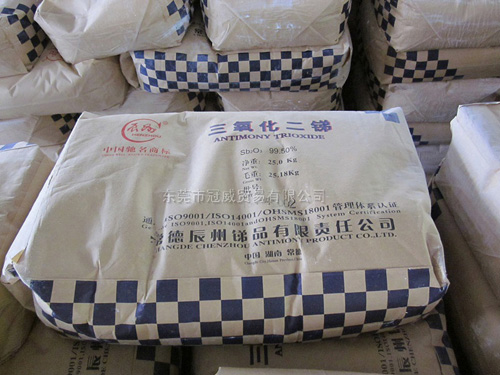
Hello, welcome to the website of Dongguan Guanwei Trading Co., Ltd.!
Guangwei Trading offers affordable and dependable
chemical raw material procurement solutions.
Hello, welcome to the website of Dongguan Guanwei Trading Co., Ltd.!
Guangwei Trading offers affordable and dependable
chemical raw material procurement solutions.

Click to view the SGS certificate for antimony trioxide
Click to view the MSDS details for antimony trioxide
Click to view the electron microscope images of antimony trioxide
Antimony Trioxide| Grade | Sb2O3 | PbO | CuO | As2O3 | Fe2O3 | Se | Cd |
| Standard Grade | ≥99.8% | ≤0.05% | ≤0.0015% | ≤0.05% | ≤0.003% | ≤0.0008% | ≤0.0005 |
| Melting Point | 656℃ |
| Boiling Point | 1425℃ |
| Density | 5.2 |
| Whiteness | 90 degrees |
| Fineness | 0.4~1.2μm |
| Molecular Weight | 291.6 |
| CAS No. | 1309-64-4 |
1. Used by plastic processors as a synergistic flame retardant in thermoplastic and thermoset formulations, with end uses in transportation, construction and structural materials, electrical appliances, wires and cables, and furniture in industrial sectors;
2. Used by rubber processors in rubber products that require flame retardancy, such as rubber hoses, belts, carpet backing, and other rubber goods;
3. Used by automobile manufacturers in PVC seat covers, carpets, and other rubber components inside or under car hoods;
4. Used by synthetic fiber producers indirectly as a processing catalyst; antimony oxide plays an important role in the esterification of polyethylene terephthalate resins and fibers;
5. Used by glass manufacturers as an oxidation-reduction clarifying agent; in the glass coloring process, antimony oxide reduces some metals (including iron, manganese, and chromium), lowering their valence to achieve stronger glass colors;
6. Used by ceramics and glaze producers as a bright, transparent white coloring agent embedded in glass or oil materials; this coloring agent is widely used in enameled cast iron bathtubs;
7. Used by paint manufacturers for flame retardant white colors, and when combined with other metals, it forms yellow colors 41, 53, and 118;
8. Used by paper product manufacturers as an essential component in flame-retardant papers, which can be used for household insulation products;
9. Used by chemical producers to make a special heat stabilizer (thiol antimony) for PVC, recognized by the FDA; also used as an intermediate in organic and inorganic compounds, and by phosphor lamp manufacturers to activate calcium halophosphate phosphor;
10. Used by solid lubricant manufacturers as a synergist for molybdenum disulfide, playing a role in aerospace lubrication.